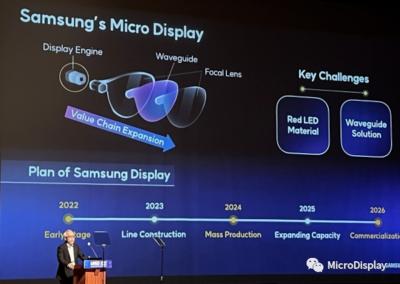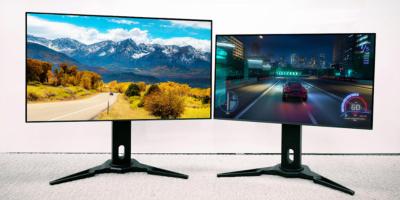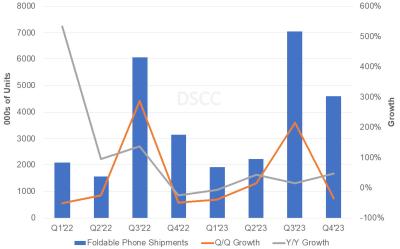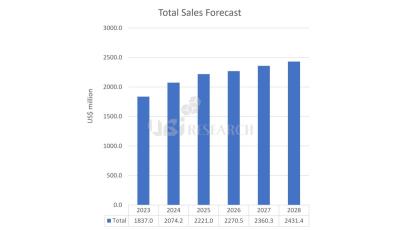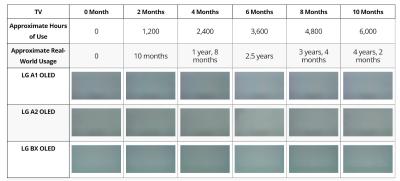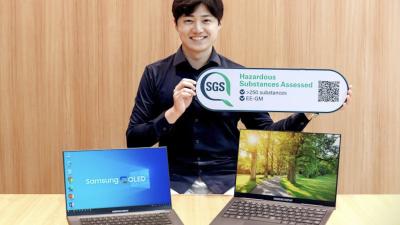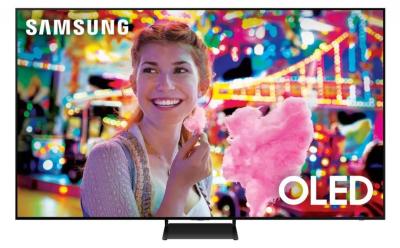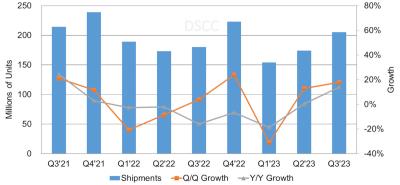OLED is an emerging display technology that is fast becoming the mainstream display technology in many markets, as OLED enables display panels that offer the best image quality and free design as they can be made flexible and transparent. The Samsung OLED displays are considered to be the best in the industry and the Korean company is the clear lead in AMOLED production for mobile devices.
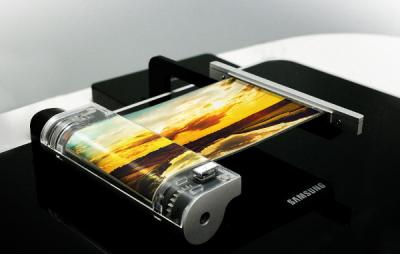
Over the pay years Samsung invested billions of dollars in OLED research and production facilities as the company sees OLEDs fast replacing LCD displays in all mobile applications.
Samsung AMOLED displays
Samsung is currently producing over 300 million AMOLED displays in a year, used mostly in smartphones - such as Samsung's own Galaxy S7 (and S7 edge ) - but also in smartphones from Gionee, Meizu, Acer, HP, Vivo, Microsoft, Lenovo, ZTE, Hisense, Konka and others. Samsung also produces large mobile OLEDs for tablets, laptops and monitors.
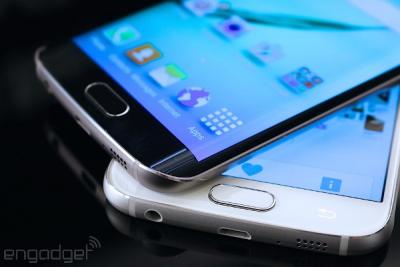
In August 2013 Samsung launched the company's first OLED TV, the KN55S9C, which used a curved 55" OLED panel. The TV was priced at around $8999 in the US and Korea, but is no longer in production, and was never in real mass production. In 2022, Samsung returned to OLED TV production, and is now offering QD-OLED panels and its first such TV is the S95B.
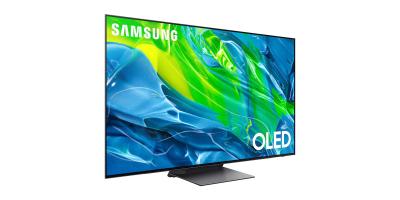
Samsung flexible OLED displays
Following its initial flexible OLED production launch in 2013, and the huge success of its edge-type phones, Samsung is currently producing around 9 million flexible OLEDs each month to satisfy demand for the Galaxy S7 edge and its other flexible OLED products. Samsung has reportedly been chosen to supply 100 million flexible OLED panels to Apple's future iPhones.
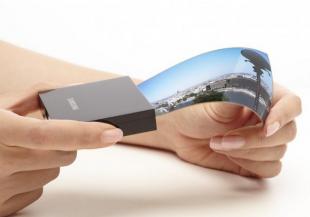
Future Samsung OLED devices
Samsung is developing several next generation display technologies based on OLEDs. Samsung has been developing a foldable OLED device for a long time - which may dramatically change the mobile device market as it could enable smartphone to turn into tablets or phones that can be folded into smaller devices.
Samsung is also developing transparent OLEDs (see the company's 55" FHD transparent and mirror-type OLEDs here) for retail application, and also readies next generation displays for the automotive industry.
Several years ago Samsung released the following video, showing a concept transparent flexible AMOLED tablet device. It will be years before Samsung can commercialize such a display, but it's nice to see what the future holds:
Further reading
The latest Samsung OLED news:
Samsung : SDC to focus on OLED microdisplays while SSI will handle its Micro-LED development
In 2022, Samsung Display confirmed it is developing OLED microdisplays, and the company has since stepped up its efforts to bring OLED microdisplay to the market. The company is also developing microLED microdisplays.
It is now reported in Korea that Samsung Electronics decided that from now on, Samsung Display will handle all OLED microdisplay projects, while Samsung Semiconductor (SSI, or specifically, the Compound Semiconductor Solutions team) will handle all microLED microdisplay development.
SDC upgrades its QD-OLED line, starts producing 31.5" 4K panels
Samsung Display announced that it is beginning to produce a new 31.5" 4K QD-OLED. This is SDC's highest density QD-OLED display, at 140 PPI. The company recently upgraded its QD inkjet printing deposition system to support this higher resolution. It will also enable SDC to produce 8K 65" QD-OLED displays (that will also be 140 PPI).
Samsung Display also announced that next year it will start producing 27" QHD QD-OLED monitor panels that will support a 360Hz refresh rate, targeting the gaming monitor market.
DSCC: 2023 is a mixed year for foldable smartphone, shipments to reach 15.8 million units
DSCC estimates that foldable smartphone shipments reached 7 million units in Q3 2023, up 16% from last year and 215% from last quarter, as Samsung successfully launched the ` and Z Fold 5 phones, and other smartphone brands from China also ramped up their foldable smartphone sales.
Samsung's market share in the smartphone market was 72%, followed by Huawei (9%) and Honor (8%). DSCC expects foldable smartphone sales to fall 35% in the next quarter (but rise 47% compared to last year) on lower Samsung shipments and delays in new product announcements. In 2023, DSCC sees foldable smartphone shipments to reach 15.8 million units in total.
UBI Research: OLED material sales to reach $2.43 billion in 2028
UBI Research updated its forecast for the OLED material industry, saying that total sales of OLED materials will grow from $1.84 billion in 2023 to $2.43 billion in 2028, a growth of 5.8% CAGR.
UBI says that in 2028, SDC will purchase OLED emitters in $810 million, LGD in $550 million and BOE in $440 million.
Rtings.com posts the results of its 10-month OLED and LCD display longevity tests
RTINGS.com posted an interesting article, detailing the results of their long-term (10-months) longevity tests on several OLED and LCD TVs and monitors. The test is simple - display a CNN feed constantly, and checking what happens. Note that CNN changed their logo a bit a few months into the test, but the team did not make any changes to the test itself.
As is expected, OLED monitors and TVs suffer from image retention problems, and the CNN logo is visible in some of these panels, when showing a gray screen. Some TVs suffer more than others.
SGS awards Samsung's laptop OLED displays with its Green Mark for low levels of potential hazardous substrances
Evaluation services provider SGS has awarded Samsung Display's OLED laptop displays with its SGS Green Mark ECCS, HSA) following completion of a hazardous substance assessment.
SGS tested SDC's laptop OLEDs to precisely verify the presence of, and to quantify the volume of, over 300 hazardous substances of environmental concern which may be harmful to humans and the environment. This includes heavy metals, persistent organic pollutants and others. Samsung Display’s OLED panels performed well, achieving low levels, below the HSA testing threshold.
UBI: Samsung to order only a limited number of WOLED TV panels from LGD in 2024
In July 2023, Samsung officially launched the 83" 83S90C, the company's first TV to use LG's WOLED panels, following several years of negotiations and hesitation by the Korean rivals.
It was assumed that Samsung's total orders from LGD will be limited (as the 83-inch are expensive and not highly popular), and according to UBI, the total number of panels that LGD actually shipped to Samsung is only 'several thousands'.
UBI: Samsung to delay the introduction its first blue phosphorescent AMOLEDs to the second half of 2025
Universal Display is progressing with its blue PHOLED material, and earlier this month the company said it is on track to introduce the new material commercially in 2024. During a company seminar, UBI's Daejeong Yoon updated that according to their latest information, Samsung Display has decided to adopt a blue phosphorescence material in the second half of 2025 - a year later than expected.
Samsung is calling the new material stack B1, and it says that the new stack will increase the efficiency of its OLED device by more than 65% (which seems to be rather too much, maybe it means 65% of the power consumption of the current stack). UBI says that the blue OLED still suffers from low lifetime - the lifetime of the blue PHOLED stack is only 55% of the lifetime of its current fluorescence-blue stack, but regardless of that the company will introduce it commercially due to the power consumption efficiency.
Reports suggest Kateeva's printers failed Samsung's QD printing tests, will not be used for QD-OLED production
According to reports, Kateeva's QD-OLED printing project saga is not over. Samsung Display tested the company's latest printers, but these failed the tests and Samsung Display will not but these printers. SDC planned to replace the currently-used Semes' printers, which also suffer from low performance.
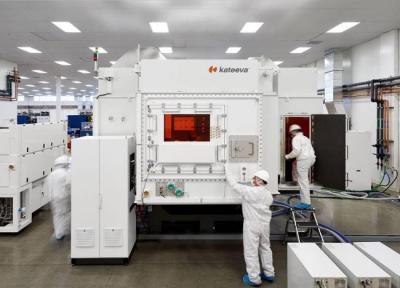
Samsung Display is also not committed yet to expand its QD-OLED production lines, which means that in any case it does not need to buy new printers for production expansion. Earlier reports suggested that SDC wanted to upgrade it current capability for higher density (to reach 8K TV printing), so this may be the reason behind the testing of Kateeva's new printers.
DSCC: OLED panel shipments increased in Q3, with strong shipments from Visionox, LGD and CSoT
DSCC reports that according to its information, OLED panel shipments in Q3 2023 increased 14% from last year (and 18% from the previous quarter) to reach 205 million units. There are positive signs that inventory has started to rebalance for some categories.
OLED smartphone shipments increased 12% over last quarter (and 25% from last year), while OLED TV shipments continue to be soft, and dropped 14% from last quarter and 40% (!) from last year.
Pagination
- Previous page
- Page 4
- Next page
